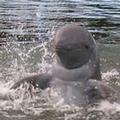 國際海洋哺乳動物保護區首屆大會4月上旬於夏威夷茂宜島召開,公佈一項太平洋海洋生物觀賞的新準則;期間,孟加拉灣也傳出消息,有6000多隻罕見的海豚出沒。
國際海洋哺乳動物保護區首屆大會4月上旬於夏威夷茂宜島召開,公佈一項太平洋海洋生物觀賞的新準則;期間,孟加拉灣也傳出消息,有6000多隻罕見的海豚出沒。
該會議是由夏威夷座頭鯨國家海洋保護區(Humpback Whale National Marine Sanctuary)、美國海洋暨大氣總署(NOAA)及其國際漁業局(NOAA Fisheries)聯合舉辦,總共有來自40個國家的200多位代表人員聚首在皇宮渡假酒店與會。
國家海洋保護區負責人麥因託許(Naomi McIntosh)表示,「會議一開始我們就瞭解到,其實海洋哺乳動物保護區管理人的共通點,比我們所想的還多。目前共有500多個已成立或規劃中的海洋保護區遍佈在全球90多個國家,然而,直到如今才將海洋哺乳動物、保護區專業人士和從業人員連結在一起召開首次的專屬會議。」
該會議替海洋保護區管理人員、科學家及教育學者開闢一個國際論壇,讓他們分享海洋哺乳動物保育所面臨的一般問題與解決方式。
與會代表鉅細靡遺地描述了各種型態的海洋保護區,範圍從小區域或位處偏遠地帶的保護區,到一些全球公認位處高度發展區的保護區都有。而與會的還包括來自阿根廷、澳洲、巴西、法國、墨西哥、紐西蘭、挪威及美國等國家的國際捕鯨委員會(IWC)代表。另外,也有來自國際自然保育聯盟、美國國家公園署、美國海洋哺乳動物委員會、海洋生物保護區、鯨豚保育協會,以及黑海、地中海和鄰近大西洋區域的鯨魚保育協定等代表人員參與該會議。
會中,國際動物福利基金會(International Fund for Animal Welfare)3月30日發表由13個太平洋島國35位代表所訂定區域性準則,也就是首次橫跨太平洋島嶼的賞鯨準則。野生生物保育協會3月31日公佈,在孟加拉孫德爾本斯紅樹林(Sundarbans mangrove forest)淡水區及鄰近孟加拉灣(Bay of Bengal)水域附近發現了大量罕見的伊何海豚(Irrawaddy dolphin)。
在這之前,伊何海豚曾經出現的最大數量約為幾百隻左右。「隨著淡水環境和海洋現狀的研究消息陸續公佈,野生動物保育協會(Wildlife Conservation Society)發現大量伊河海豚現蹤在孟加拉的消息,點燃了我們保護伊河海豚、其它瀕危物種及重要棲地的希望,」野生動物保育協會董事長兼總執行長桑德森(Steven Sanderson)表示。
桑德森說道,「野生動物保育協會承諾將會保育這類標竿物種,包括海豚、海龜、鯊魚及大型鯨魚等。」
The discovery of 6,000 rare dolphins in Bangladesh and new guidelines for marine wildlife viewing in the Pacific Islands are among the announcements made this week at the First International Conference on Marine Mammal Protected Areas underway on the island of Maui.
More than 200 delegates from 40 countries are gathered at the Grand Wailea Hotel for the conference hosted by the Hawaiian Islands Humpback Whale National Marine Sanctuary, the National Oceanic and Atmospheric Administration and the NOAA Fisheries Office of International Affairs.
"An immediate outcome from this conference is the recognition that managers of marine mammal protected areas have more in common than we realized," said Naomi McIntosh, Hawaiian Islands Humpback Whale National Marine Sanctuary superintendent.
"There are more than 500 existing or proposed Marine Protected Areas for marine mammals in some 90 countries," McIntosh said, "yet this is the first dedicated gathering of marine mammal and MPA experts and practitioners."
The conference provides an international forum for Marine Protected Area managers, scientists and educators to share common challenges and solutions in the protection of marine mammals.
Delegates represent marine protected areas of every description, from small or remote locations to sophisticated globally recognized sites. A number of delegates to the International Whaling Commission are in attendance, including those representing Argentina, Australia, Brazil, France, Mexico, New Zealand, Norway and the United States.
Also represented are the International Union for Conservation of Nature, U.S.National Park Service, the U.S. Marine Mammal Commission, Pelagos Sanctuary, the Whale and Dolphin Conservation Society, and Agreement on the Conservation of Cetaceans of the Black Sea, Mediterranean Sea and contiguous Atlantic Area.
On Monday, the International Fund for Animal Welfare announced the first regional guidelines for responsible whale and dolphin watching across the Pacific Islands, developed by 35 representatives from 13 Pacific Island governments.
On Tuesday, the Wildlife Conservation Society revealed the discovery of a large population of rare Irrawaddy dolphins living in freshwater regions of Bangladesh's Sundarbans mangrove forest and adjacent waters of the Bay of Bengal - an area where little marine mammal research has taken place up to this point.
Before this study, the largest known populations of Irrawaddy dolphins numbered in the low hundreds. "With all the news about freshwater environments and state of the oceans, WCS's discovery that a thriving population of Irrawaddy dolphins exists in Bangladesh gives us hope for protecting this and other endangered species and their important habitats," said Dr. Steven Sanderson, president and chief executive of the Wildlife Conservation Society, which is based at New York's Bronx Zoo.
"WCS is committed to conservation of these iconic marine species from dolphins, sea turtles, sharks to the largest whales," he said.




